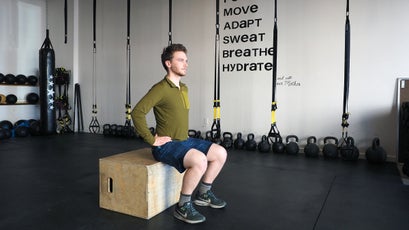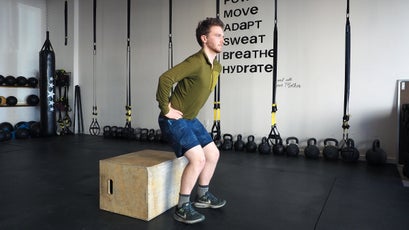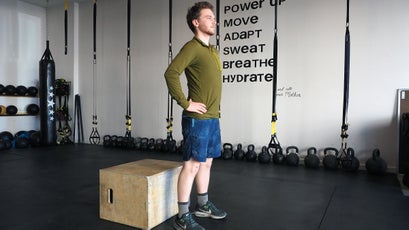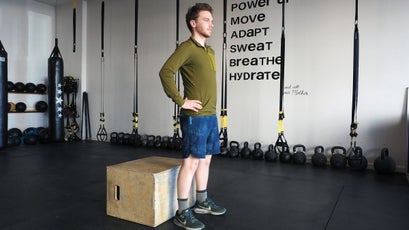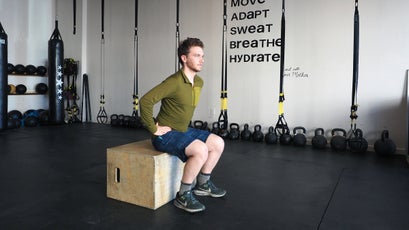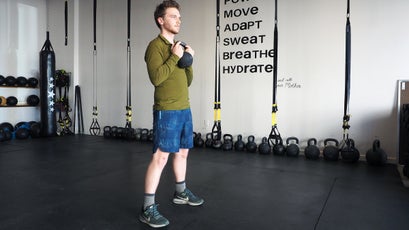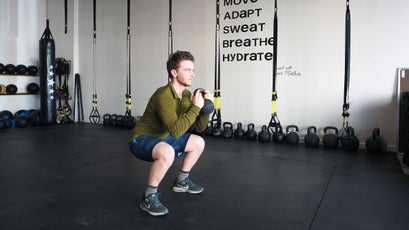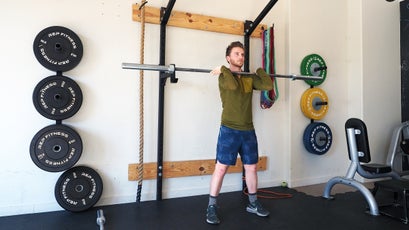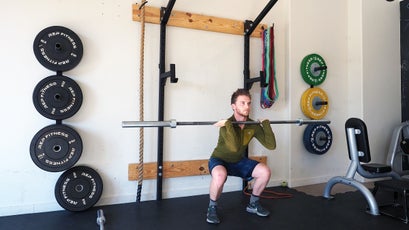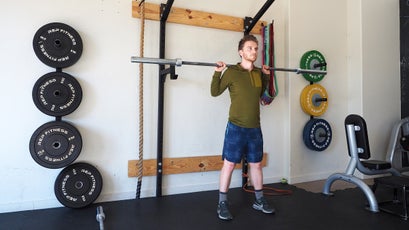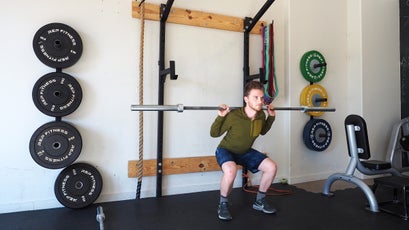Squats might seem simple, but theyÔÇÖre actually incredibly technicalÔÇöand easy to mess up. Carolyn Parker, a╠ř instructor and the founder of the╠ř in Carbondale, Colorado, estimates that 90 percent of the people╠řwho╠řwalk into her gym, including both╠řrecreational athletes╠řand professionals, could use some serious help with their squats.
ÔÇťOutdoor athletes typically donÔÇÖt have a gym base╠řand have never been taught how to squat properly,ÔÇŁ she says. ÔÇťThey just move their bodies in the mountains in╠řthe way that feels easiest.ÔÇŁ When we prefer to play outside instead of hit the gym, we typically overdo it and neglect strength, stretching, and mobility work. ÔÇťThatÔÇÖs where we start to see poor form and injury,ÔÇŁ Parker says.
When done correctly, the squat is the ultimate exercise to build strength, power, and mobility in the legs. Across all squat variations, the primary muscles involved are the quadriceps, ▓Á▒˘│▄│┘▒ż▒╠ř│ż▓╣│Šż▒│żż▒, and the large hip adductors on the inner thigh. While these are the main movers, other muscle groups engage to act as stabilizers, such as╠řthe calves,╠řhamstrings, erector spinae (back), core,╠řand obliques, depending on the type of squat and how youÔÇÖre carrying the weight.
, a coach, author of╠ř, and a leading expert on glute training, has conducted many experiments to measure muscle activity during exercises╠řand found that all types of squats essentially do the same thing. ÔÇťMost squat and single-leg variations elicit similar levels of muscle activation, even if they feel different,ÔÇŁ he says. The findings reinforce the point that thereÔÇÖs no need to get fancy with complicated squat variationsÔÇöthey only offer subtle differences in the balance of muscle activation. But there is something to be said for starting with the easiest version╠řof a basic squat and gradually ramping up the difficulty.╠řIf youÔÇÖre new to squatting, or working with limited mobility, starting slow╠řwill keep you injury-free.
Below,╠řParker and Contreras walk through╠řthe basics of proper squat form╠řthrough a progression of exercises.
How to Do a Perfect Squat
Stand tall, with your feet shoulder-width apart╠řor slightly wider╠řand your toes facing forward or slightly angled out. A wider stance with angled feet might work better if you lack ankle mobility. The important thing here is to feel stable and comfortable. Stand with your toes on a line to ensure one foot is not in front of the other. Keep your hips level and square.
Hold your chest and head high. Look directly forward, not up or down, to keep your neck in a neutral position. Pull your shoulders back and down, and engage your core muscles. Keep your spine stacked in a neutral position throughout the movement, without leaning forward or rounding your back (although itÔÇÖs╠řOK╠řto maintain the natural curve in your lower back).
Shift your weight to over your heels. (You should be able to wiggle your toes.) Bend your knees╠řand hinge forward at the hips at the same rate to lower into the squat. Keep your hips square, your torso upright, and your spine neutral throughout the movement. Engage your glutes, and push through your heels to stand up.
When you lower into a squat, your knees should track over your toes╠řbut not beyond, and they╠ř╠řat any time, since this motion is associated with╠řknee pain. If you cannot maintain adequate knee control,╠řstrengthen your glutei╠řmedii╠ř(hip abductors) first. Keep your nose, knees, and toes vertically aligned, like thereÔÇÖs an invisible wall in front of you.
Squat depth is achieved through hip flexion and ankle dorsiflexion, Contreras says, not the rounding of the spine. YouÔÇÖll only be able to go as far as your mobility allows with good form. While some people can drop their butts to their heels in a full squat, that range of motion isnÔÇÖt usually necessary in outdoor sports. ÔÇťFor mountain athletes, the sweet spot for depth is an inch below having your quads parallel to the floor,ÔÇŁ says Parker.
If you attempt to go too low for your mobility, you will likely compensate by rounding your back and compromising lumbar stability. Deep squats, even with excellent form, can also stress the hip joints and lead to╠řhip pain. ÔÇťThereÔÇÖs no need to risk injury to the knees and other joints,ÔÇŁ Parker adds.
Focus on one aspect at a time, to shore up your weakness, and if you have any doubts, work with a coach or a trainer. As you practice, youÔÇÖll gradually improve your form, awareness, and range of motion╠řand will ultimately increase your athletic potential. ÔÇťItÔÇÖs a lot to focus on at once, and mastery can take a while,ÔÇŁ Parker says. ÔÇťBut if you take the time to truly learn the movement, in three to six months youÔÇÖll be a different athlete.ÔÇŁ The progression below will help you get there.
The Moves: Squat Progression╠ř
Master the first three moves in the order listed before adding weight. Then╠řprogress to╠řhigh repsÔÇöaround 15ÔÇöand low weight (you should still have a few reps in the gas tank when youÔÇÖre done). As your form improves and you get stronger, gradually increase the╠řamount of weight and the number of sets, and lower the number of reps per set. Start with the first three exercises, and only move to╠řthe final three once youÔÇÖve perfected the easier variations.
Sit to Stand (Box Squat)
What it does: Trains proper stance, spinal stability, and glute activation. Mountain athletes tend to be quad dominant and underutilize their glutes to come up out of a squat, says Parker, so you must learn to engage the glutes to make sure they share the workload.
How to do it: Sit on the edge of a box or a bench (ideally one that comes to just below your knees in height so that your thighs are parallel to the floor when you sit). Place your hands on your hips, square your feet in front of you, and engage your glute musclesÔÇöas in, actively squeeze your buttÔÇöthen stand until your knees are fully extended. Reverse the movement to sit again, and repeat. Focus on proper squat form and glute activation.
If youÔÇÖre struggling to maintain good form, try a variation:╠řstart standing, squat to sit on the box, then stand up again. While itÔÇÖs often used as a teaching tool, powerlifters will occasionally bring back the box for loaded squats to improve performance. Keep the box in mind as you progress.
Volume: Two to three sets of 10 to 15 reps
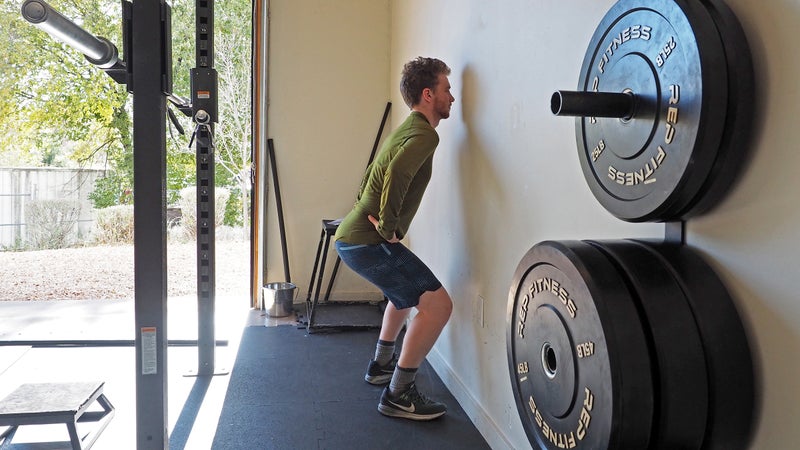
Wall Squat
What it does: Trains a correct nose-knees-toes alignment, using the wall as a barrier to enforce upright form, and improves hip and ankle mobility.
How to do it: Stand facing a wall, with your feet hip-width apart or slightly wider╠řand your toes a few inches away. Hold your chest and head high, pull your shoulders back and down, and keep your spine in a neutral position. Shift your weight to your heels, place your hands on your hips, then gently guide them backward as you bend your knees to lower into a squat. Focus on working the hips backward while maintaining a neutral spine. Lower until your thighs are an inch or two below parallel to the floor, or as far as your mobility will allow without breaking form, then press through the heels to stand up. Move slowly and in control. For this exercise, depth is less important than form.
Volume: Three sets of ten╠řreps
Squat to Box
What it does: Strengthens the squatting muscles while practicing proper form. ÔÇťThe box ensures youÔÇÖre going to the same depth every rep, instead of progressively skimping on range of motion as you fatigue,ÔÇŁ╠řsays Contreras.
How to do it: Perform this exercise as you would for box squats, but instead of sitting on the box every repetition, squat until you lightly tap the box with your butt, without fully╠řsitting down, then stand up again, and repeat.
Like with the box squat, start with a taller box if you lack the ankle and hip mobility. As your mobility and strength improve, gradually decrease the box height until you can perform the exercise with good form on a box thatÔÇÖs just below knee level in height.
Volume: Three sets of ten╠řreps
Goblet Squat
What it does: Strengthens the main squatting musclesÔÇöthe quads, glutes, and adductorsÔÇöand also activates the back and core muscles as stabilizers. The kettlebell acts as a counterweight, which can help you stay upright and achieve greater depth with good form.
How to do it: Perform╠řsquats as described above while holding a kettlebell or a dumbbell with both hands at chest level. Remember to keep your feet and hips square, your spine neutral, and your knees tracking over your second toesÔÇöbut not beyond. Keep your weight over your heels, and lower only as far as you can with good form, then push through the heels to stand up.╠ř
Volume: Three to four sets of eight to ten╠řreps
Front Squat
What it does: Strengthens the main squatting muscles. These place more load on the anterior chain (front of the body) and put more emphasis on the quads as opposed to the glutes. The bar allows you to increase the load of╠řthe goblet squat, which is limited to the weights of kettlebells. As with the goblet squat, holding the load in front of your body can help with muscle activation and to stay upright, so most people find it easier than a back squat.╠ř
How to do it: With an overhand grip, grab a barbell with your hands slightly wider than shoulder-width apart, then ),╠řso╠řit rests on the front of your shoulders with your elbows parallel and high. Perform squats as described above.
Volume: Three to four sets of eight to ten╠řreps
Back Squat
What it does: Strengthens the main squatting muscles. These place more load on the posterior chain (back of the body) and put more emphasis on the glutes╠řas opposed to the quads.
How to do it: Stand beneath the barbell in a rack, position it on the back of your shoulders, and grasp the handle with a wide, comfortable grip. Keep your elbows back and your shoulder blades engaged. Stand up to remove the barbell from the rack, and perform squats as described above.
Volume: Three to four sets of eight to ten╠řreps
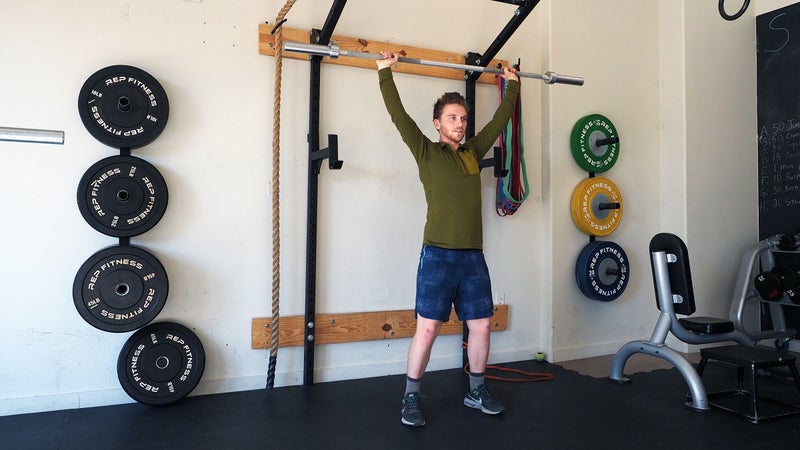
Overhead Squat
What it does: Works the typical squat muscles, with the addition of the deltoids (shoulders) and trapezii╠ř(upper-back muscles) to lift and stabilize the barbell overhead.
How to do it: No matter how good you think you are at front and back squats, the overhead squat is a different game. ÔÇťI have very few of my athletes do these,ÔÇŁ says Parker. ÔÇťItÔÇÖs a complex movement, and most people do not have the combined hip and shoulder mobility to do it safely.ÔÇŁ Try these only once you have mastered squat technique and have adequate hip and shoulder mobility.
Start with a piece of PVC pipe to focus on technique before adding weight, and return to the wall. Hold the pipe with a wide overhand grip, then . Keep your elbows fully extended with the bar in the air, slightly behind your head. Step up to face the wall, a few inches away, and perform squats as described above.
Once you have the overhead wall squat nailed, move away from the wall and practice it with a barbell only, then gradually add weight.╠ř
Volume: Three to four sets of six to eight reps


